Photographs of
|
|
|
|||||||||
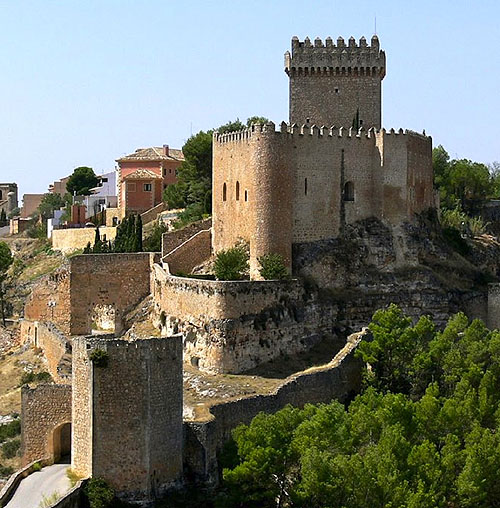 |
Alarcon Castle Cuenca, Castile-La Mancha, Spain.
In 1177 Ferren Martínez de Ceballos led the Christian forces which captured Alarcón - then an important fortress - from the Almohads. |
||||||||
|
|
|||||||||
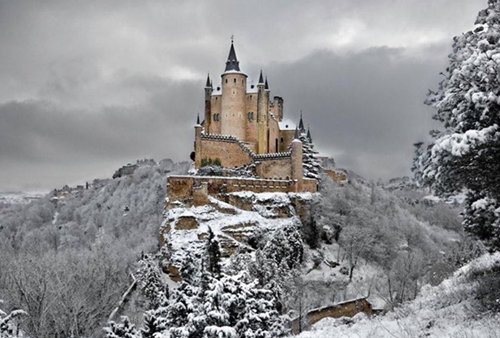
|
Alcazar, Segovia, Spain
The Alcázar of Segovia (literally, Segovia Castle) is a stone fortification, rising out on a rocky crag above the confluence of the rivers Eresma and Clamores near the Guadarrama mountains.
It is one of the most distinctive castle-palaces in Spain, shaped like the bow of a ship.
The Alcázar of Segovia, like many fortifications in Spain , started off as an Arab fort, which itself was built on a Roman fort but little of that structure remains. It has served as a royal palace, a state prison, a Royal Artillery College and a military academy since Moorish times. |
||||||||
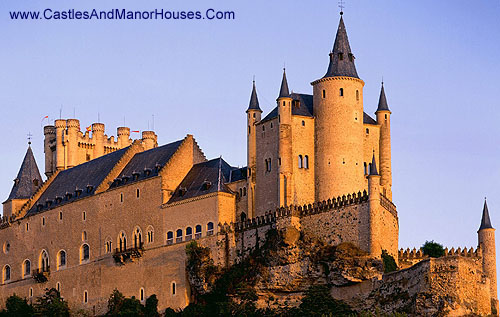
|
The Alcázar of Segovia (Segovia Castle) Segovia Spain |
||||||||
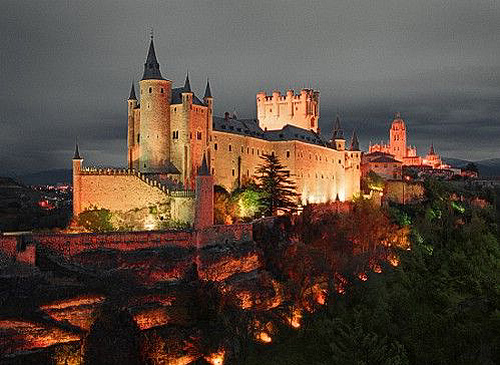 |
The Alcázar of Segovia (Segovia Castle) is located in the old city of Segovia, Spain.
Rising out on a rocky crag above the confluence of the rivers Eresma and Clamores near the Guadarrama mountains, it is one of the most distinctive castle-palaces in Spain
Alcázar (from Arbic for "The Castle") was originally built as a fortress but has served as a royal palace, a state prison, a Royal Artillery College and a military academy. |
||||||||
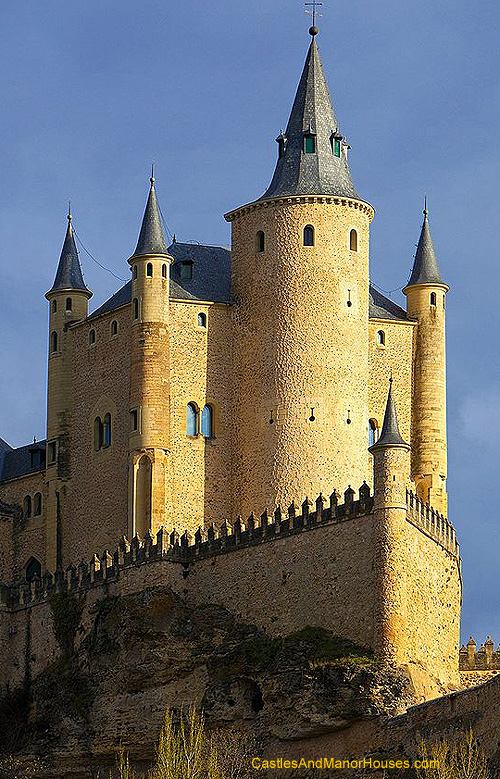 |
Alcazar Segovia, Spain
The Alcázar of Segovia (literally, Segovia Castle) is a stone fortification, rising out on a rocky crag above the confluence of the rivers Eresma and Clamores near the Guadarrama mountains. It is one of the most distinctive castle-palaces in Spain, shaped like the bow of a ship.
The Alcázar of Segovia, like many fortifications in Spain , started off as an Arab fort, which itself was built on a Roman fort but little of that structure remains.
It has served as a royal palace, a state prison, a Royal Artillery College and a military academy since Moorish times. |
||||||||
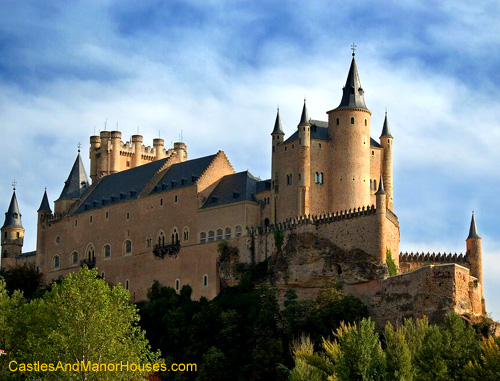 |
Alcazar, Segovia, Spain
The Alcázar of Segovia (literally, Segovia Castle) is a stone fortification, rising out on a rocky crag above the confluence of the rivers Eresma and Clamores near the Guadarrama mountains.
It is one of the most distinctive castle-palaces in Spain, shaped like the bow of a ship.
The Alcázar of Segovia, like many fortifications in Spain , started off as an Arab fort, which itself was built on a Roman fort but little of that structure remains. It has served as a royal palace, a state prison, a Royal Artillery College and a military academy since Moorish times. |
||||||||
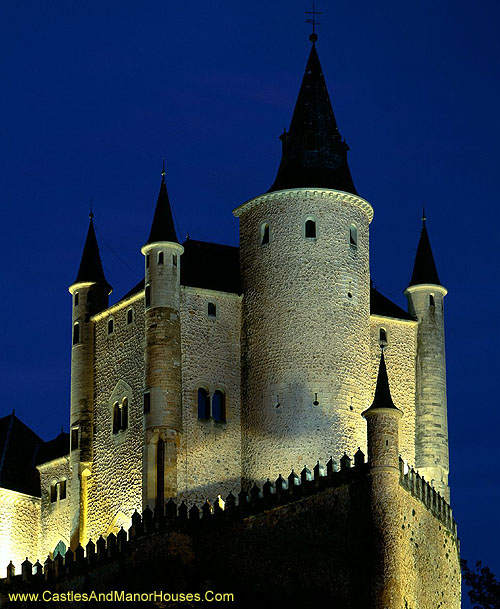 |
Alcazar Segovia, Spain.
The Alcázar of Segovia (literally, The Castle of Segovia) is a stone fortification, rising out on a rocky crag above the confluence of the rivers Eresma and Clamores near the Guadarrama mountains.
It is one of the most distinctive castle-palaces in Spain, shaped like the bow of a ship. (The photo shows only part of it)
The Alcázar of Segovia, like many fortifications in Spain, started off as an Arab fort, which itself was built on a Roman fort but little of that structure remains. It has served as a royal palace, a state prison, a Royal Artillery College and a military academy since Moorish times. |
||||||||
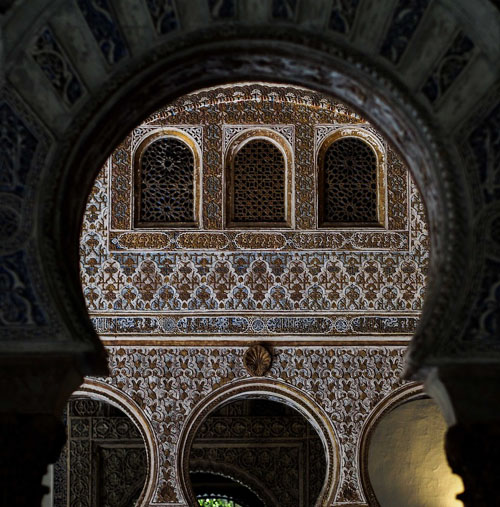 |
Alcazar, Seville, Spain
The Alcázar of Seville is known in Spanish as the "Reales Alcázares de Sevilla" litterally the Royal Alcazars of Seville,
It is a royal palace, originally a Moorish fort. It is the oldest royal palace still in use in Europe, and it was registered in 1987 by UNESCO as a World Heritage Site.
The Almohades were the first to build a palace, which was called Al-Muwarak, on the site of the modern day Alcázar. The palace is one of the best remaining examples of mudéjar architecture. Subsequent monarchs made their own additions to the Alcázar.
The upper levels of the Alcázar are still used by the royal family as the official Seville residence and are administered by the Patrimonio Nacional. |
||||||||
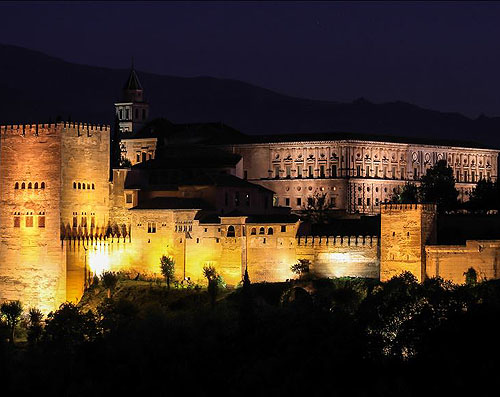 |
Alhambra Palace, Granada, Andalusia, Spain
The Alhambra (Calat Alhambra) is a palace and fortress complex, originally constructed as a small fortress in 889 and rebuilt in the mid 11th century by the Moorish king Mohammed ben Al-Ahmar of the Kingdom of Granada.
It was converted into a royal palace in 1333 by Yusuf I, Sultan of Granada. The Alhambra's Islamic palaces were built for the last Muslim emirs in Spain and its court of the Nasrid dynasty. After the Reconquista by the Reyes Católicos ("Catholic Monarchs") in 1492, some portions were used by Christian rulers. The Palace of Charles V, built by Charles V, Holy Roman Emperor in 1527, was inserted in the Alhambra within the Nasrid fortifications.
It is now one of Spain's major tourist attractions, exhibiting the country's most significant and well known Islamic architecture, together with 16th-century and later Christian buildings and gardens.
The Alhambra is a UNESCO World Heritage Site |
||||||||
 |
Alhambra Palace, Granada, Andalusia, Spain
The Alhambra (Calat Alhambra) is a palace and fortress complex, originally constructed as a small fortress in 889 and rebuilt in the mid 11th century by the Moorish king Mohammed ben Al-Ahmar of the Kingdom of Granada.
It was converted into a royal palace in 1333 by Yusuf I, Sultan of Granada. The Alhambra's Islamic palaces were built for the last Muslim emirs in Spain and its court of the Nasrid dynasty. After the Reconquista by the Reyes Católicos ("Catholic Monarchs") in 1492, some portions were used by Christian rulers. The Palace of Charles V, built by Charles V, Holy Roman Emperor in 1527, was inserted in the Alhambra within the Nasrid fortifications.
It is now one of Spain's major tourist attractions, exhibiting the country's most significant and well known Islamic architecture, together with 16th-century and later Christian buildings and gardens.
The Alhambra is a UNESCO World Heritage Site |
||||||||
|
|
Aljaferia Zaragoza Spain
The Aljafería Palace is a fortified medieval Islamic palace in the Moorish taifa of Zaragoza of Al-Andalus |
||||||||
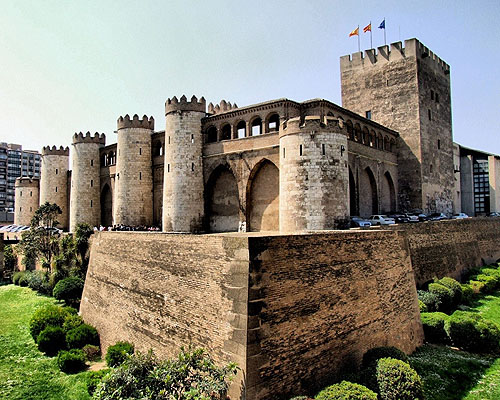 |
The Aljafería Palace Zaragoza Spain |
||||||||
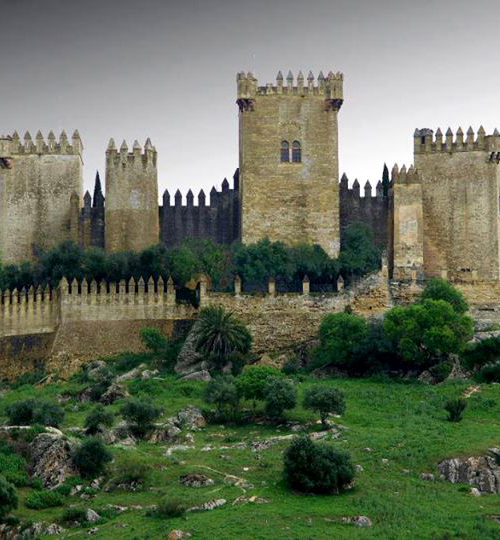 |
Almodovar Castle Almodóvar del Río, Province of Córdoba, Spain.
It is situated 15 miles (24 km) from Córdoba, on the left bank of the Guadalquivir.
Previously a Roman fort, the Moors built a castle on the site. The current structure has Berber origins, and dates from the year 760. During the Middle Ages, the castle underwent several periods of reconstruction. |
||||||||
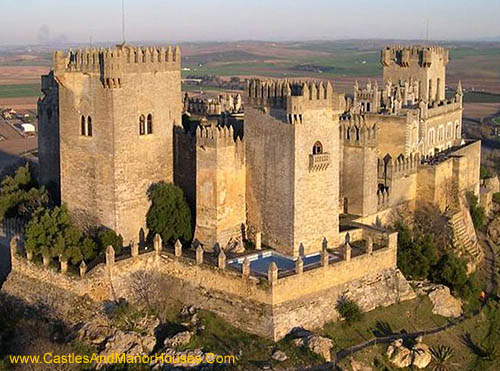 |
Castillo de Almodóvar del Río Almodóvar del Río, Province of Córdoba, Spain.
It is situated 15 miles (24 km) from Córdoba, on the left bank of the Guadalquivir.
The Moors built a castle here on the site of a Roman fort. The current structure has Berber origins, and dates from the year 760. During the Middle Ages, the castle underwent several periods of reconstruction. |
||||||||
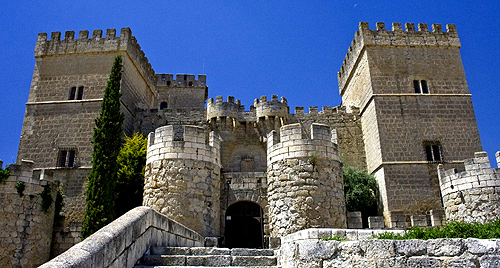 |
Castle of Ampudia Palencia Castile and León Spain |
||||||||
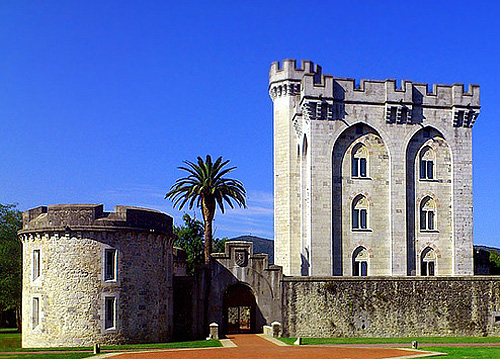 |
Arteaga Tower, Biscay, Basque Country, Spain
The Arteaga Tower is a medieval castle rebuilt in the 19th Century for the French empress Eugénie de Montijo
Napoleon III and Eugenia de Montijo had it rebuilt when their son was proclaimed an honorary citizen of Biscay. |
||||||||
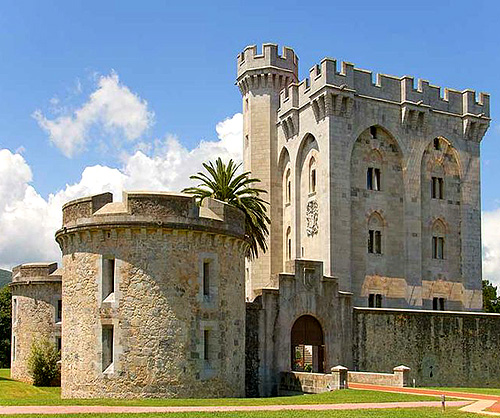 |
Arteaga Tower, Biscay, Basque Country, Spain
The Arteaga Tower is a medieval castle rebuilt in the 19th Century for the French empress Eugénie de Montijo Napoleon III and Eugenia de Montijo had it rebuilt when their son was proclaimed an honorary citizen of Biscay. |
||||||||
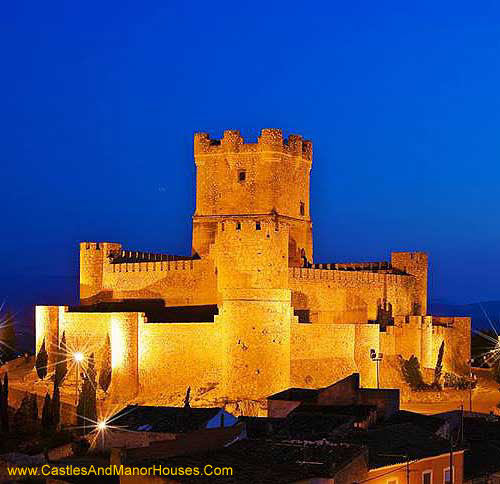 |
Atalaya Castle (Castillo de la Atalaya or Castillo de Villena) Villena, province of Alicante, southern Spain.
It commands the former frontier between Castile and Kingdom of Aragon. |
||||||||
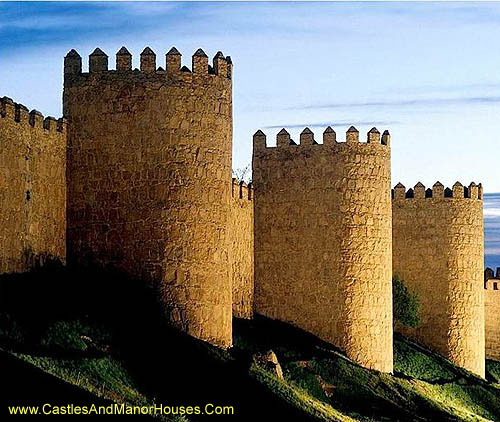 |
Ávila Town walls Ávila, Castile and León, Spain.
Ávila is sometimes called the Town of Stones and Saints. It is notable for having complete and prominent medieval town walls, built in the Romanesque style.
The town is also known as Ávila de los Caballeros, Ávila del Rey and Ávila de los Leales (Ávila of the Knights, the King and the Loyalists). It is "perhaps the most 16th-century town in Spain". It was declared a UNESCO World Heritage Site in 1985. |
||||||||
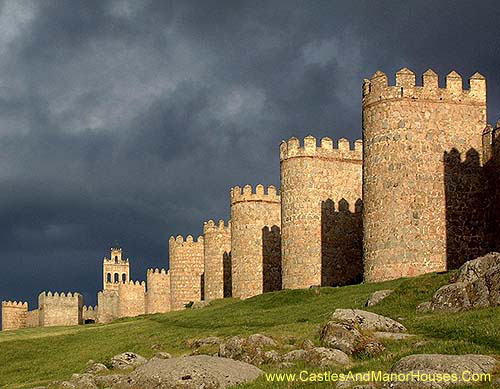 |
Ávila Town walls Ávila, Castile and León, Spain.
Ávila is sometimes called the Town of Stones and Saints. It is notable for having complete and prominent medieval town walls, built in the Romanesque style.
The town is also known as Ávila de los Caballeros, Ávila del Rey and Ávila de los Leales (Ávila of the Knights, the King and the Loyalists). It is "perhaps the most 16th-century town in Spain". It was declared a UNESCO World Heritage Site in 1985. |
||||||||
 |
The Roman walls of Barcelona. Barcelona is now the capital city of the autonomous community of Catalonia in Spain
The founding of Barcelona is the subject of two different legends. The first attributes the founding of the city to Hercules. The second to the Carthaginian Hamilcar Barca, (father of Hannibal) who named the city Barcino after his family in the 3rd century BC.
About 15 BC, the Romans created a castrum here centred on the "Mons Taber". The colony bore the name of Faventia, in full, Colonia Faventia Julia Augusta Pia Barcino, or Colonia Julia Augusta Faventia Paterna Barcino.. The Roman city minted its own coins. The typically Roman grid plan is still visible today in the layout of the historical centre. Some fragments of the Roman walls have been incorporated into the cathedral.
The city was subsequently conquered by the Visigoths in the early 5th century. After being conquered by the Arabs in the early 8th century, it was conquered in 801 by Charlemagne's son Louis, who made Barcelona the seat of the Carolingian "Hispanic March" (Marca Hispanica), a buffer zone ruled by the Count of Barcelona. |
||||||||
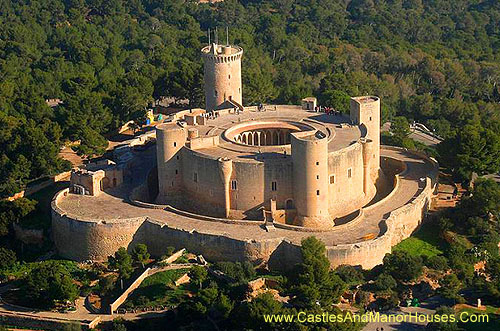
|
Bellver Castle Northwest of Palma Majorca Balearic Islands Spain |
||||||||
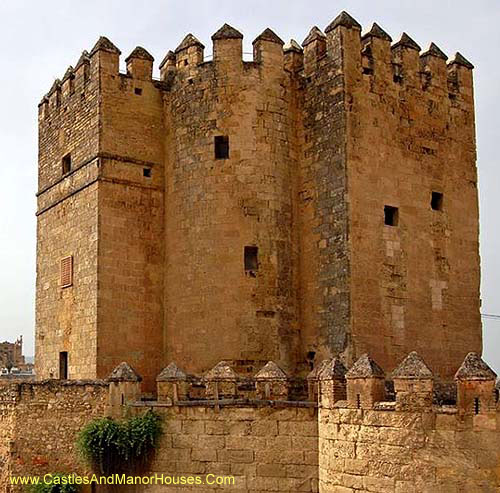 |
Torre de la Calahorra (Calahorra Tower) Córdoba, Spain
The tower is a fortified gate of Islamic origin.It was built during the late 12th century by the Almohads to protect the nearby Roman Bridge on the Guadalquivir. The tower, standing on the left bank of the river, originally consisted of an arched gate between two square towers.
The building was restored in 1369 by king Henry II of Castile. A third tower was added to the existing ones, in the shape of two cylinder connecting them.
The tower was declared a national historical monument in 1931. |
||||||||
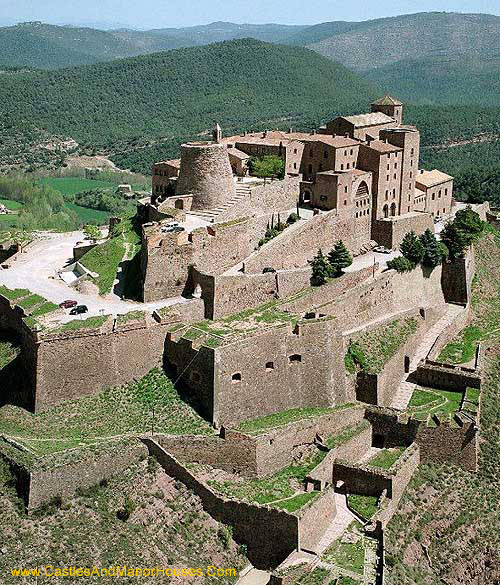 |
Parador de Cardona or Castell de Cardona Cardona, Barcelona, Catalonia, Spain |
||||||||
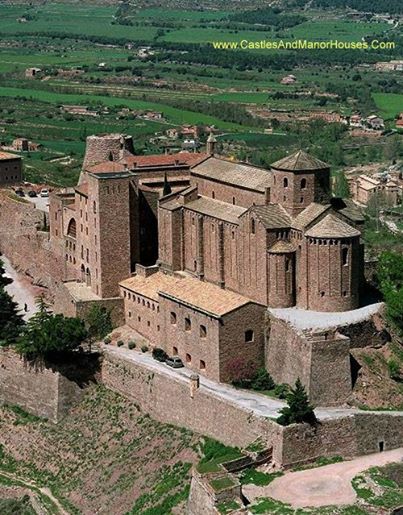 |
The Castle of Cardona, Cardona, Catalonia, Spain.
The Castle of Cardona (Catalan: Castell de Cardona) is a medieval fortress situated on a hill overlooking the valley of the Cardener river. A fortress was constructed here by Wilfred the Hairy in 886. The 11th century torre de la minyona is a tower measuring 15 metres in height and 10 in diameter. A Romanesque Church dedicated to Sant Vicenç de Cardona stands adjacent to the castle.
Today the castle is used as a parador, a state-run hotel. Because of its history, it has become significant to the Catalonian independence movement |
||||||||
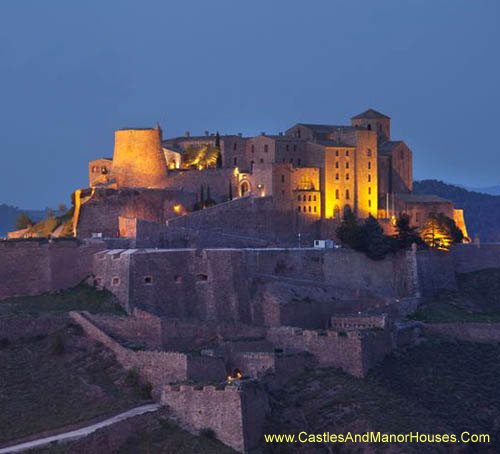 |
Castle of Carmona Carmona, Seville, Spain |
||||||||
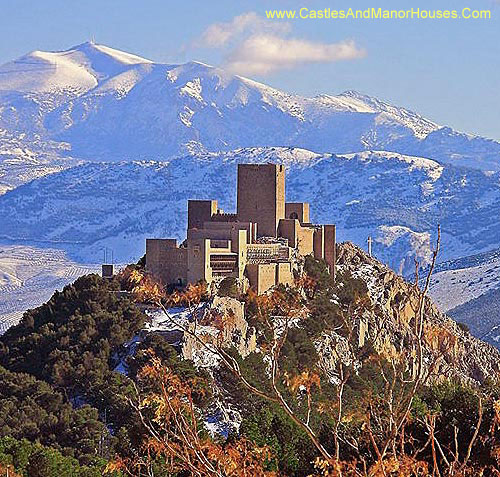 |
Saint Catalina's Castle (Castillo de Santa Catalina) Cerro de Santa Catalina, overlooking the city of Jaén, Andalusia, Spain
The castle began as an 8th Century Moorish fortress last improved by the Nasrid King Abdallah ibn al-Ahmar (who also built Alhambra). Earlier there was a tower known as Hannibal's Tower, of which traces remain. After King Ferdinand III of Castile captured the city in 1246 following the Siege of Jaén, he commenced a transformation of the castle, including construction of what became known as the New Castle on the eastern extreme of the hill.
The construction in 1965 of a parador resulted in the destruction of many of the elements of the Old Castle. The few remnants of the original fortress occupy the western extreme of the hill. |
||||||||
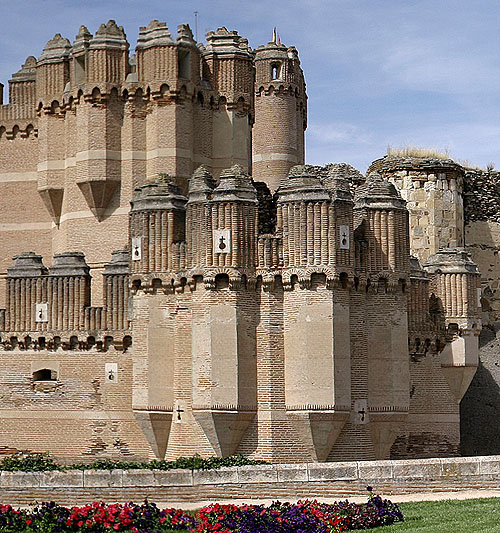 |
Coca Castle Coca Segovia Castile-Leon Spain |
||||||||
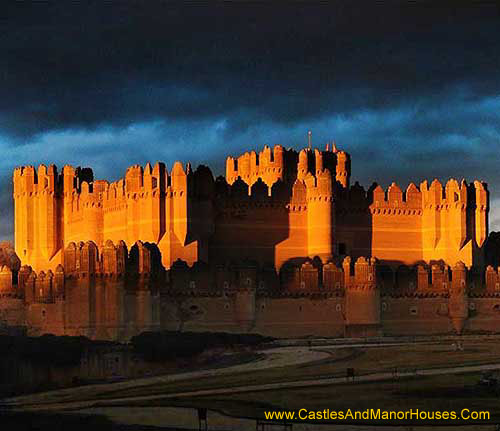 |
Coca Castle Coca, Segovia, Castile-Leon, Spain
The castle was built on the site of ancient Cauca, the birthplace of the Roman emperor Theodosius. This area was populated by the Arevaca in the 2nd century BC.
Begun in 1448 by Don Alonso de Fonseca (1418–1473), Bishop of Avila and Archbishop of Seville, the castle wast still unfinished at the end of the 15th century.
Coca is an example of the Mudéjar style, combining elements drawn from Islamic traditions with Flamboyant Gothic. |
||||||||
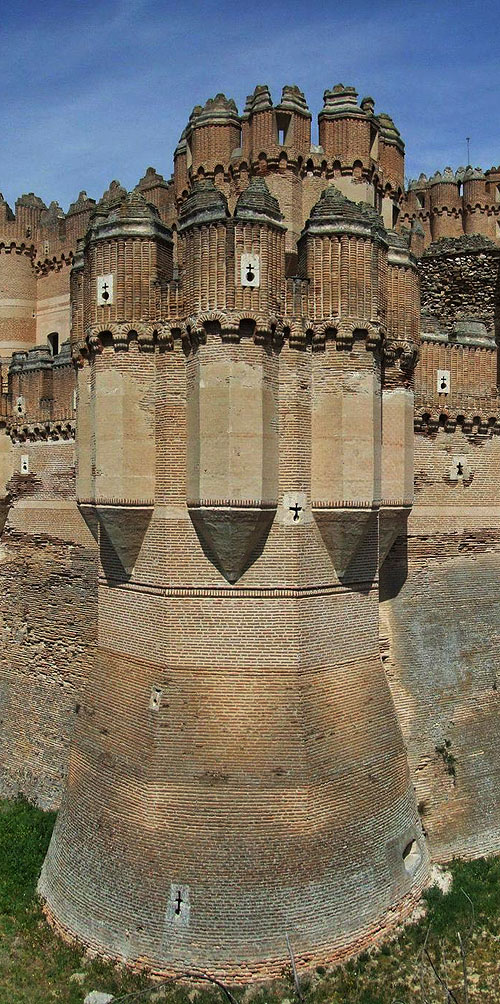 |
Coca Castle Coca Segovia Castile-Leon Spain |
||||||||
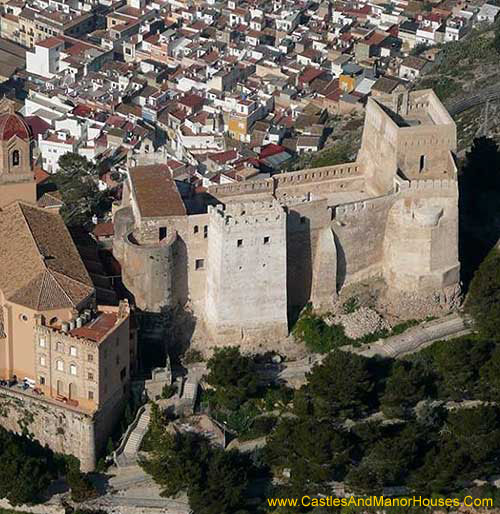 |
Castillo de Cullera Cullera, Valencia, Spain |
||||||||
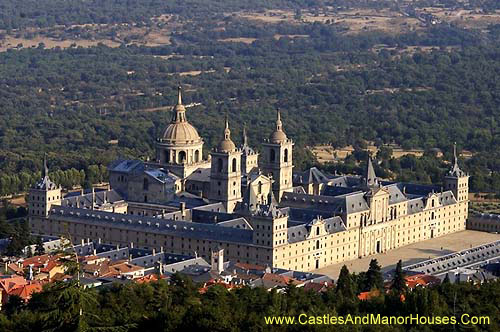 |
San Lorenzo de El Escorial northwest of Madrid, Spain.
El Escorial is a historical residence of the King of Spain, It functions as a monastery, royal palace, museum, and school. Originally a property of the Hieronymite monks, the monastery monastery now belongs to the Order of Saint Augustine. Philip II of Spain, engaged the Spanish architect, Juan Bautista de Toledo, to be his collaborator in the design of El Escorial. Philip appointed him architect-royal in 1559, and together they designed El Escorial as a monument to Spain's role as a center of the Christian world. On 2 November 1984, UNESCO declared The Royal Seat of San Lorenzo of El Escorial a World Heritage Site. |
||||||||
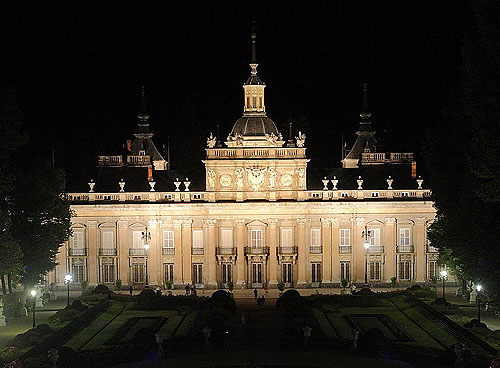 |
The Royal Palace of La Granja de San Ildefonso, San Ildefonso, near Segovia, Spain.
The Royal Palace of La Granja de San Ildefonso in known in Spanish as the Palacio Real de La Granja de San Ildefonso. It is an 18th-century palace, the summer residence of the Kings of Spain from the reign of Philip V.
The palace was built in a restrained baroque style, surrounded by extensive gardens in the French manner, with sculptural fountains.
It is now open to the public as a museum. |
||||||||
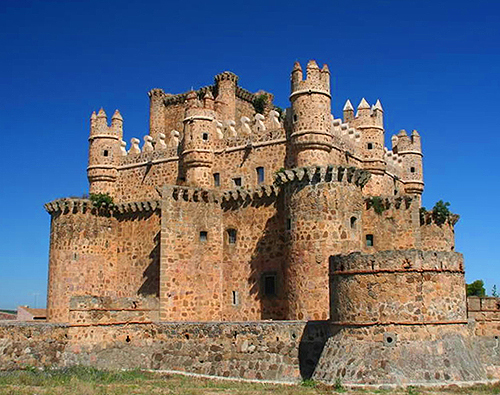 |
Castle of Guadamur |
||||||||
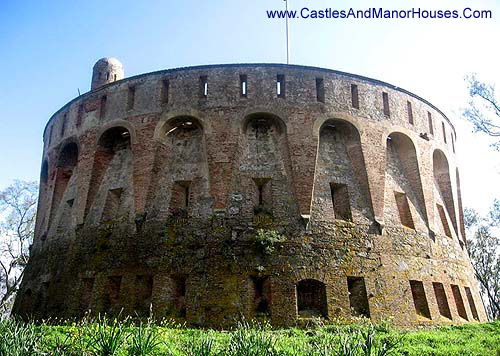 |
Fort Isabell II (Fuerte Isabel II), Ceuta, Spain
Ceuta is an autonomous city of Spain located on the Mediterranean, on the North African side of the Strait of Gibraltar, which separates it from the Spanish mainland |
||||||||
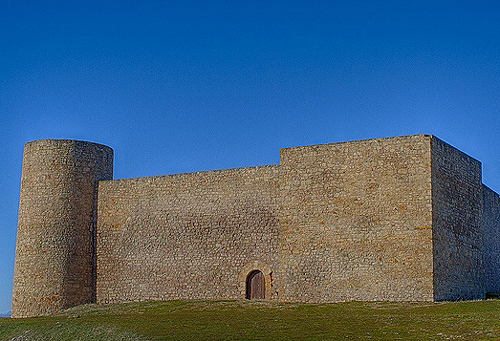 |
Castillo de Medinaceli, Soria, Spain
The optimal number of windows for a defensive building. |
||||||||
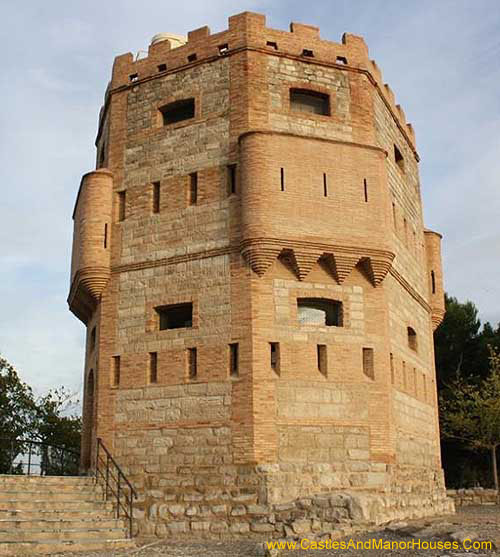 |
La Torre Monreal Tudela, Navarra, Spain
A tower of Arab origin |
||||||||
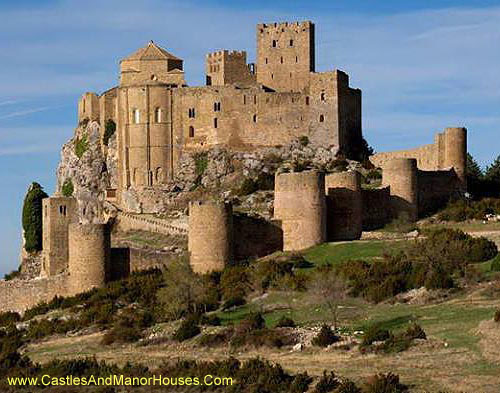 |
Castillos de Monzón y Loarre Loarre, Huesca. Spain.
The Loarre castle complex was built largely during the 11th and 12th centuries, when its position on the frontier between Christian and Muslim lands gave it strategic importance.
The first of the two major building programs began ca. 1020, when Sancho el Mayor (r. 1063–94) reconquered the surrounding lands from the Muslims. At least three towers, two of which survive, the Homage tower (Torre del Homenaje) and the "Tower of the Queen" (Torre de la Reina), are attributed to this campaign.
The Homage tower was built in an isolated position in front of the fortifications, to which it was connected by a wooden bridge. The Torre de la Reinahas both Lombard and Mozarabic architectural forms. |
||||||||
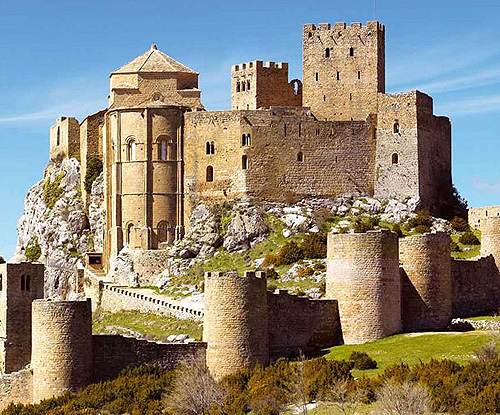 |
Castillos de Monzón y Loarre Loarre, Huesca. Spain.
The Loarre castle complex was built largely during the 11th and 12th centuries, when its position on the frontier between Christian and Muslim lands gave it strategic importance.
The first of the two major building programs began ca. 1020, when Sancho el Mayor (r. 1063–94) reconquered the surrounding lands from the Muslims. At least three towers, two of which survive, the Homage tower (Torre del Homenaje) and the "Tower of the Queen" (Torre de la Reina), are attributed to this campaign.
The Homage tower was built in an isolated position in front of the fortifications, to which it was connected by a wooden bridge. The Torre de la Reinahas both Lombard and Mozarabic architectural forms. |
||||||||
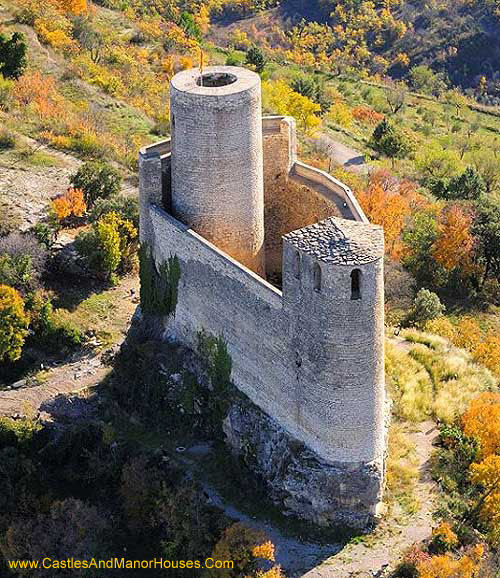 |
Castell de Mur Lleida, Catalonia, Spain |
||||||||
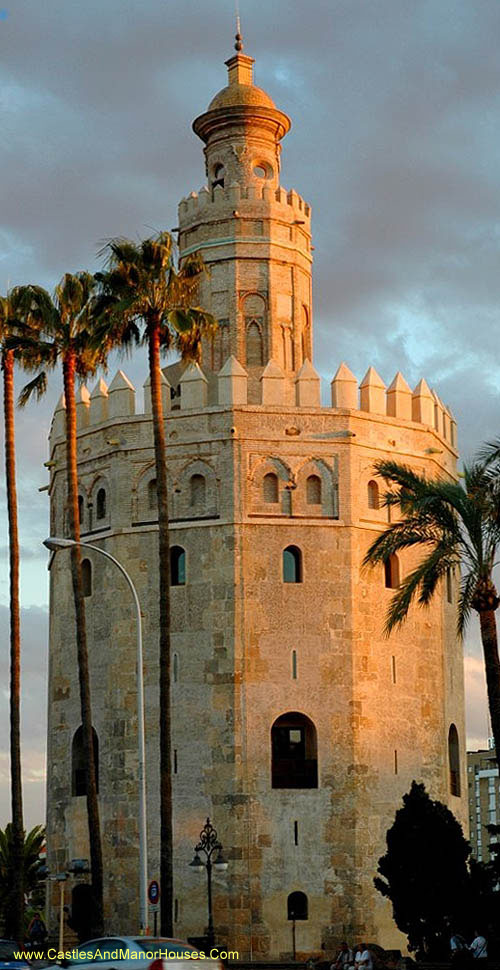 |
La Torre del Oro, Seville, Spain |
||||||||
 |
The Palacio Real (Royal Palace)
The Palacio Real de Madrid is the official residence of the Spanish Royal Family in Madrid, but is only used for state ceremonies.
A foreign ambassador arrives at the Royal Palace to deliver his diplomatic credentials to the King |
||||||||
 |
Castle of Santiago Sanlúcar de Barrameda, Cádiz province, Andalucía, Spain.
The Castle of Santiago was constructed by the Second Duke of Medina-Sidonia (Enrique Perez de Guzman y Meneses) between 1477 and 1478. The style is late Gothic. The castle is rectangular with towers around a central courtyard. |
||||||||
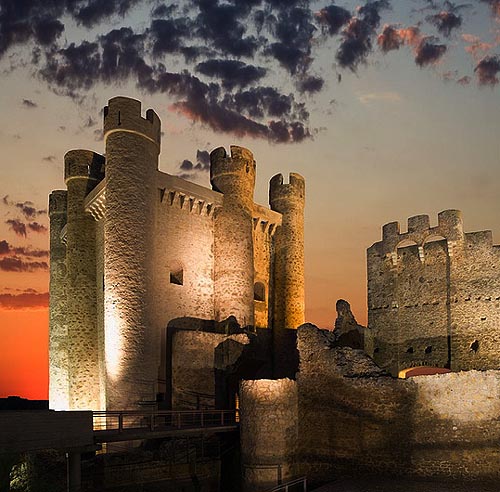 |
Valencia de Don Juan León, Castile and León, Spain.
Originally called Valencia de Campos, it was renamed after its First Lord, Infante John of Portugal. |
||||||||
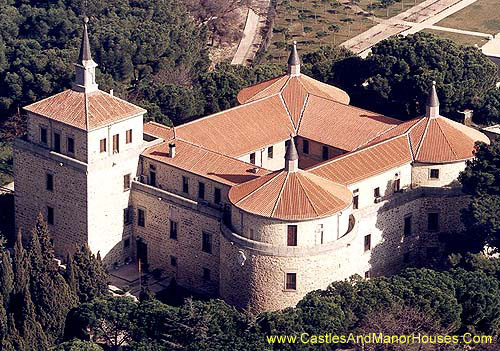 |
Castillo de Villaviciosa de Odón, Madrid, Spain
The Castle of Villaviciosa de Odón is a palace-fortress complex found in the small town of the same name near Madrid, Spain.
|
||||||||
|
|
|||||||||
|
|
|||||||||
|
|
|
|
|||||||
|
|
|||||||||
| :::: Link to us :::: Castle and Manor Houses Resources ::: © C&MH 2010-2014 ::: contact@castlesandmanorhouses.com ::: Advertising ::: |